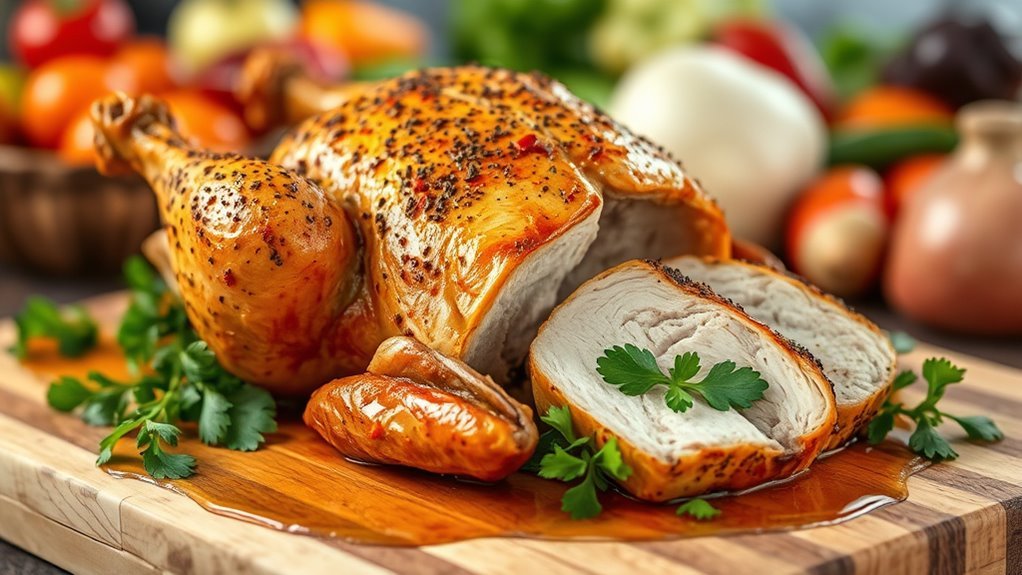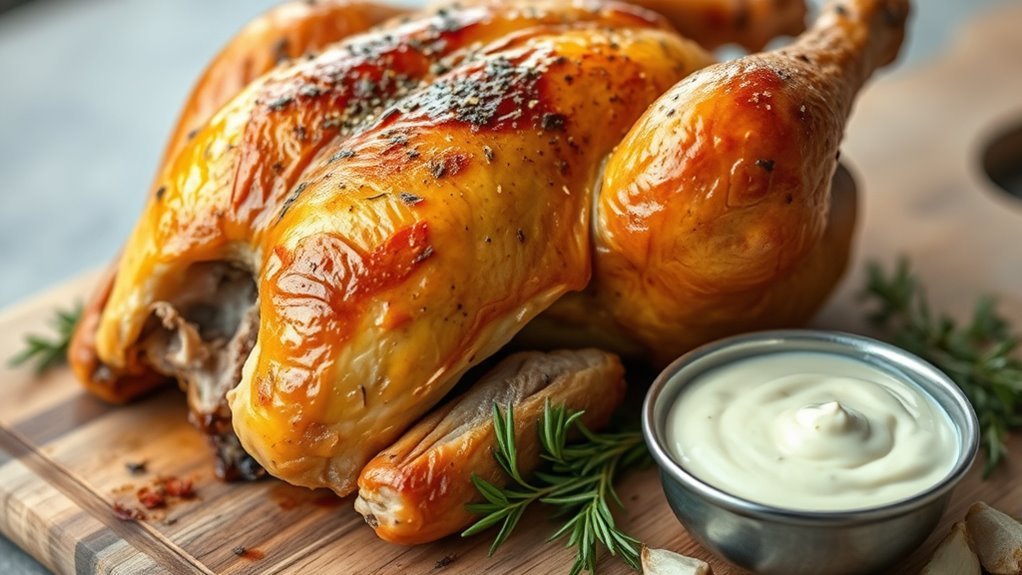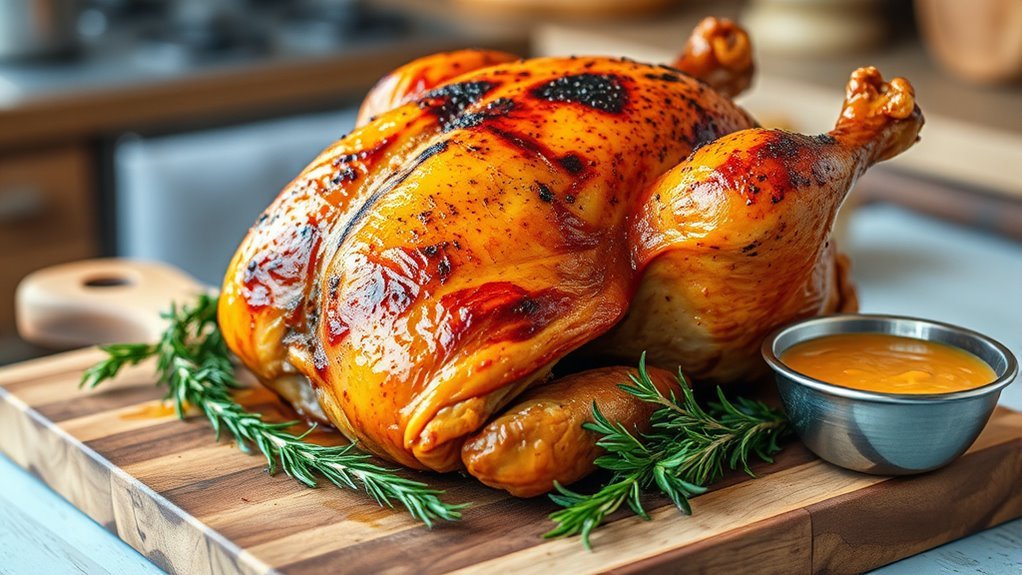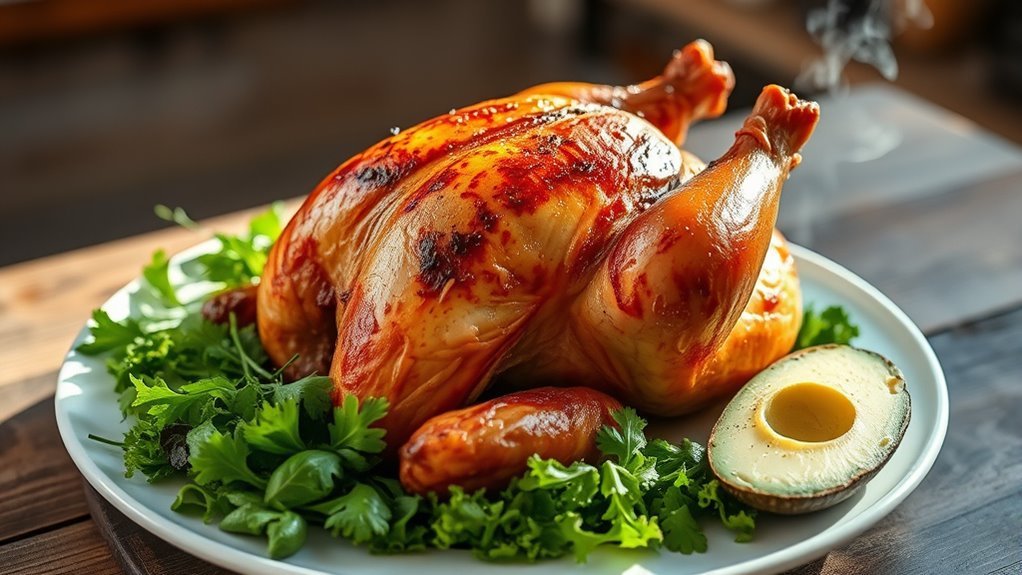Yes, rotisserie chicken is a keto-friendly option. It’s high in protein and healthy fats, fitting well within the ketogenic diet’s macronutrient ratios. Just be mindful of added sugars and preservatives in the seasoning. A typical serving provides minimal carbohydrates, often under 1 gram, especially when enjoyed with the skin. You can easily incorporate it into your meals for variety. If you’re curious about the best ways to select and use rotisserie chicken, there’s more to explore.
Understanding the Ketogenic Diet

When you plunge into the ketogenic diet, you’ll find it’s not just a trend but a well-researched approach to eating that focuses on high-fat, low-carbohydrate foods. Understanding the ketogenic fundamentals is vital for your success. The diet typically involves a macronutrient ratio of about 70-75% fat, 20-25% protein, and just 5-10% carbohydrates. This shift in macronutrient ratios encourages your body to enter a state of ketosis, where it burns fat for fuel instead of glucose. By embracing this low-carb lifestyle, you gain the freedom to explore delicious, satisfying meals while promoting weight loss and improved mental clarity. Remember, it’s important to monitor your intake and choose quality sources of fats to truly thrive on this diet.
Nutritional Breakdown of Rotisserie Chicken

Rotisserie chicken is a convenient and versatile option that can fit seamlessly into a ketogenic diet. When you look at the nutritional breakdown, you’ll find that it boasts a high protein content, typically around 30 grams per serving. This makes it an excellent choice for muscle maintenance and satiety. Additionally, the fat content can vary, but it generally provides a good source of healthy fats, especially if you enjoy the skin. A standard serving can have about 15 grams of fat, which aligns well with the macronutrient ratios favored in keto. Just be mindful of any added ingredients or marinades that might sneak in extra carbs. Overall, rotisserie chicken delivers a satisfying balance of protein and fat for your keto lifestyle.
Ingredients to Look For in Rotisserie Chicken

When choosing rotisserie chicken, it’s essential to look closely at the ingredients. Pay attention to the seasoning, as some blends may include hidden sugars or carbohydrates that can affect your keto diet. Additionally, consider the balance between skin and meat, since the skin adds extra fat but can also contain unwanted additives.
Check the Seasoning
While enjoying a convenient meal, it’s essential to check the seasoning of rotisserie chicken to confirm it aligns with your keto diet. Many store-bought options use seasoning blends that may contain hidden sugars or carbs, so it’s vital to read the ingredient label. Look for flavor profiles that include natural herbs and spices like garlic, paprika, or pepper, which are keto-friendly. Avoid chicken seasoned with sweeteners or high-carb additives. You want to make sure your meal not only tastes great but also supports your nutritional goals. By choosing rotisserie chicken with clean ingredients, you can savor the convenience without compromising your keto lifestyle. Enjoy the freedom of flavorful meals that fit your dietary needs!
Skin vs. Meat
Choosing between the skin and the meat of rotisserie chicken can greatly impact your keto diet. The skin, often crispy with a rich texture, adds healthy fats that can support your keto goals. However, the meat provides a leaner protein source with robust flavor. It’s important to reflect on your preferences and dietary needs when deciding.
| Aspect | Skin | Meat |
|---|---|---|
| Skin Texture | Crispy, fatty | Tender, juicy |
| Meat Flavor | Savory, seasoned | Mild, adaptable |
| Nutritional Value | Higher in fat, lower in protein | High in protein, lower in fat |
Incorporating both can make your meals more satisfying while maintaining a balanced keto approach. Enjoy the freedom to choose what fits your taste!
Hidden Carbohydrate Sources
Although rotisserie chicken can be a convenient and tasty option for those following a keto diet, it is essential to be mindful of hidden carbohydrate sources that may lurk in the seasoning and ingredients. Many store-bought rotisserie chickens are pre-marinated or seasoned with blends that could contain hidden sugars. When you check the ingredient labels, look out for terms like “dextrose,” “maltodextrin,” or “brown sugar,” which can add unnecessary carbs. Additionally, some brands might use sauces or glazes that further increase the carb count. To stay true to your keto goals, opt for plain rotisserie chicken or those with minimal, clearly labeled ingredients. This way, you can enjoy your meal without compromising your dietary freedom.
Common Additives and Their Impact on Keto
When you choose rotisserie chicken, it’s important to be aware of common additives that can affect your keto diet. High sodium levels can lead to water retention, while hidden sugars may disrupt your carb intake. Additionally, preservatives and fillers can add unnecessary ingredients that don’t align with your nutritional goals.
Sodium Levels Considerations
While enjoying rotisserie chicken can fit into a keto diet, it’s essential to pay attention to sodium levels, especially since many commercially prepared options contain various additives that can greatly increase sodium content. High sodium intake can lead to water retention and may affect your overall health. Here’s a quick look at common sodium sources and alternatives:
| Sodium Sources | Common Additives | Sodium Alternatives |
|---|---|---|
| Seasoning blends | Garlic powder | Fresh herbs |
| Marinades | MSG | Lemon juice |
| Processed sauces | Soy sauce | Vinegar |
| Pre-packaged meals | Salt | Low-sodium broth |
| Cured meats | Sodium nitrite | Homemade seasonings |
Choosing lower sodium options can help you maintain that keto freedom!
Sugar Content Awareness
How can you enjoy rotisserie chicken without jeopardizing your keto diet? It’s important to be aware of added sugars in marinades and seasonings. Many rotisserie chickens come with hidden carbs that can sneak into your meal. Here are some tips to maintain carb awareness:
- Check the label: Always read ingredient lists for sugar substitutes or added sugars.
- Ask the deli staff: Inquire about ingredients to understand what you’re consuming.
- Opt for plain: Choose unseasoned rotisserie chicken when possible to avoid unnecessary carbs.
- Make your own: Prepare rotisserie-style chicken at home using keto-friendly spices and marinades.
Preservatives and Fillers
Being mindful of sugar content is just the beginning; preservatives and fillers can also impact your keto diet when it comes to rotisserie chicken. Common preservative types, like sodium benzoate and potassium sorbate, can sometimes disrupt your ketosis by adding unwanted chemicals. Filler ingredients, such as starches and sugars, might be used to enhance flavor or texture but can sneak in extra carbs. Always check the label to verify you’re not inadvertently consuming ingredients that could hinder your keto lifestyle. Opt for rotisserie chicken that lists minimal ingredients, ideally just chicken and seasonings. By being informed about these additives, you can enjoy your rotisserie chicken while staying true to your keto goals.
Portion Sizes and Carbohydrate Content
When it comes to enjoying rotisserie chicken on a keto diet, understanding portion sizes and carbohydrate content is essential for staying within your daily carb limits. A typical serving of rotisserie chicken contains minimal carbohydrates, often less than 1 gram per 3-ounce portion. To make the most of your meal, consider these tips:
- Stick to a serving size of 3-4 ounces to control your carb intake.
- Choose skin-on chicken for added healthy fats.
- Pair your chicken with low-carb veggies for a balanced meal.
- Monitor any sauces or sides, as they can add hidden carbs.
Health Benefits of Rotisserie Chicken
Although many people enjoy rotisserie chicken for its convenience and flavor, it also offers several health benefits that align well with a balanced diet. With its high protein content, rotisserie chicken provides essential amino acids that support muscle repair and growth. Its meal versatility means you can easily incorporate it into various dishes, making healthy eating enjoyable and effortless.
| Health Benefit | Description | Impact |
|---|---|---|
| High Protein | Supports muscle growth and repair | Maintains strength and energy |
| Low in Carbs | Fits perfectly in low-carb diets | Aids in weight management |
| Rich in Nutrients | Provides vitamins and minerals | Supports overall health |
| Convenient | Quick meal option | Saves time in meal prep |
| Flavorful | Enjoyable taste | Encourages healthier eating choices |
How to Incorporate Rotisserie Chicken Into Your Meal Plan
Incorporating rotisserie chicken into your meal plan can be both simple and rewarding, especially if you’re looking to maintain a healthy, low-carb diet. Here are some easy ways to enjoy it:
- Meal Prep: Shred the chicken and portion it out for quick meals throughout the week.
- Chicken Salad: Mix shredded rotisserie chicken with avocado, celery, and spices for a delicious, low-carb salad.
- Stir-Fry: Toss rotisserie chicken in a hot skillet with your favorite low-carb vegetables for a quick stir-fry.
- Soup Base: Use the chicken to create a hearty, low-carb soup by adding broth and veggies.
These ideas not only save time but also keep your meals varied and flavorful, making your keto journey enjoyable.
Comparing Homemade vs. Store-Bought Rotisserie Chicken
While both homemade and store-bought rotisserie chickens offer convenience and flavor, there are notable differences regarding nutrition, ingredients, and cost. Homemade preparation lets you control seasonings and cooking methods, which can lead to richer flavor variations tailored to your preferences. You can opt for healthier oils or add fresh herbs, avoiding the preservatives often found in store-bought options.
On the other hand, store-bought rotisserie chickens save time and effort, making them a great choice for busy days. However, they may contain added sodium and other ingredients that could affect your keto diet. Ultimately, if you’re looking for a healthier, customizable option, homemade might be the way to go, while store-bought offers undeniable convenience when you’re short on time.
Alternative Protein Sources for Keto Dieters
Finding the right protein sources is essential for anyone following a keto diet, especially if you’re looking to diversify your meals beyond rotisserie chicken. Thankfully, there are plenty of alternative protein options that align with your dietary needs.
Exploring diverse protein sources is key for keto dieters seeking variety beyond rotisserie chicken.
Here are some great choices:
- Seafood options: Salmon and shrimp are not only delicious but also rich in healthy fats.
- Egg recipes: Think frittatas or scrambled eggs—versatile and packed with protein.
- Nut-based snacks: Almonds and walnuts provide healthy fats and protein in a convenient form.
- Tofu dishes: A fantastic plant-based protein source that can be seasoned and cooked in various ways.
These alternatives can help keep your meals exciting while ensuring you stay within your keto goals.
Tips for Choosing the Best Rotisserie Chicken
When you’re on the hunt for the best rotisserie chicken, how do you guarantee you’re making a healthy choice? Start by checking the ingredient list. Look for whole ingredients and avoid those with added sugars or preservatives. Next, consider the flavor profiles; spiced or herb-infused options often enhance your meal without extra calories. Pay attention to the cooking methods used—prefer chickens that are roasted rather than fried, as this helps retain moisture without excessive fat. Finally, inspect the skin; while it adds flavor, it can also increase calories. By focusing on these factors, you can enjoy a delicious rotisserie chicken that aligns with your health goals and satisfies your taste buds.
Frequently Asked Questions
Can I Eat the Skin on Rotisserie Chicken While on Keto?
You can definitely eat the skin on rotisserie chicken while on keto! It’s rich in healthy fats, making it a tasty option for your low-carb lifestyle. The skin provides additional flavor and texture, plus it offers skin benefits like collagen. Just guarantee you balance it out with other keto-friendly options, like non-starchy veggies, to keep your meals nutritious. Enjoy the freedom to savor that delicious chicken skin guilt-free!
How Many Carbs Are in Different Rotisserie Chicken Flavors?
You might think all rotisserie chicken flavors are loaded with carbs, but that’s not necessarily true. The nutritional breakdown varies by seasoning. For instance, plain rotisserie chicken has about 0 grams of carbs, while flavors like BBQ can contain around 5-10 grams per serving due to added sugars. Always check the specific flavor variations for accurate carb counts, allowing you to enjoy your meal without compromising your dietary goals.
Is Rotisserie Chicken Safe for Meal Prepping on Keto?
Absolutely, rotisserie chicken’s a great option for meal prep! It’s convenient, packed with protein, and can easily be stored in airtight containers. Just make certain you separate the meat from the bones and refrigerate it promptly to maintain freshness. You can enjoy it in various keto-friendly meals throughout the week. Just keep an eye on any marinades or seasonings to guarantee they fit your carb goals. Enjoy your freedom to create delicious, easy meals!
Are There Gluten-Free Rotisserie Chicken Options Available?
You might be wondering if you can enjoy rotisserie chicken without worrying about gluten. The good news is, many brands offer gluten-free options, but you’ll want to check labels carefully. Some come pre-seasoned with gluten-free sauces, while others are plain, allowing you to customize with your favorite gluten-free seasoning options. Just make sure you’re aware of cross-contamination risks if you’re highly sensitive. Freedom in flavor is possible; it just takes a bit of vigilance.
Can I Eat Rotisserie Chicken Daily on a Keto Diet?
You can eat rotisserie chicken daily on a keto diet, and it can actually offer several keto benefits. Its high protein content supports muscle maintenance while keeping carbs low, which is essential for ketosis. However, be mindful of seasoning and sauces that may contain hidden sugars. Daily consumption can be part of a balanced approach, just make sure you’re incorporating a variety of other low-carb foods to maintain nutritional diversity and overall health.


